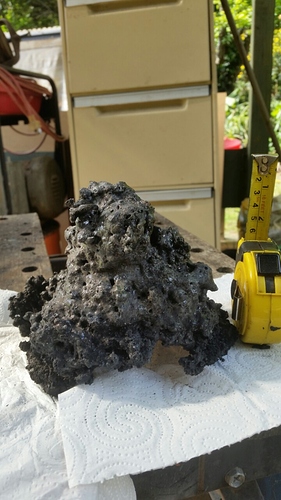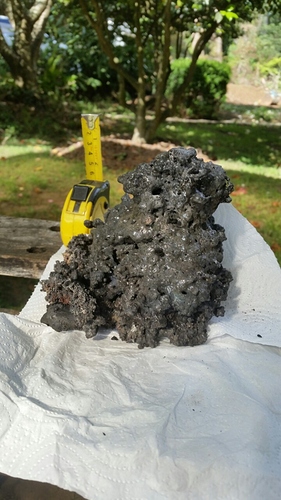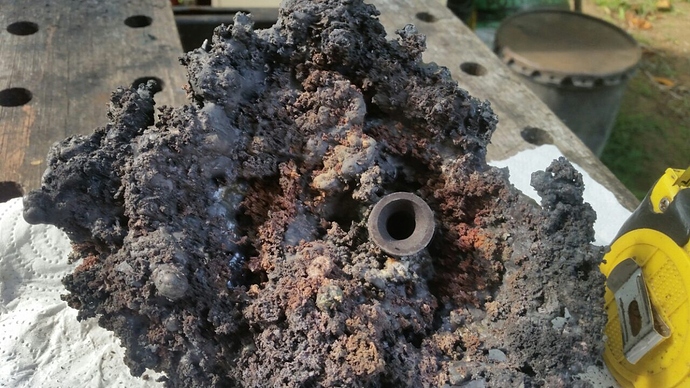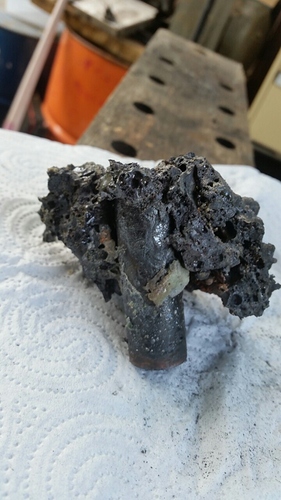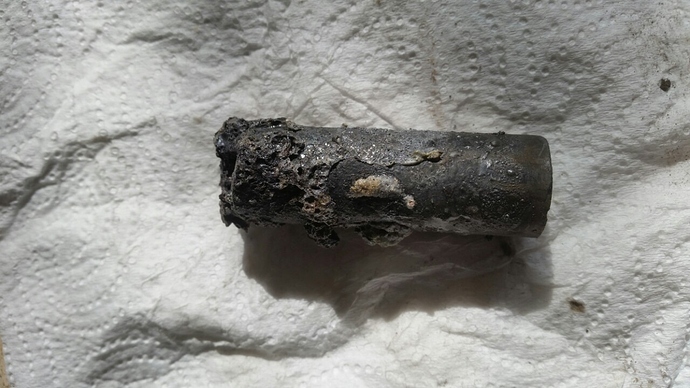Dave, Any update on the carbide nozzle?
Hi Bruce , at the moment i have the supposedly tungsten carbide nozzle still intact and working , ,i am now in spring here and sunshine more days than not so i am now only running maybe 3 days a week , i can feel some warmth when i shut down the air inlet tap so i would imagine in the next few weeks i will empty out the drum and take a look and report how good or bad it went .
I also have the very large silicon carbide nozzle sat here waiting to be tested out and i am keen to see how well that one will hold up as well , but if i get to the stage where i dont need to run for a week or more i may empty the gasifier and see if i can make a down facing nozzle with a funnel shape cast in refractory and use this nozzle in the center as described by Max , will let you know what i go with soon .
Dave
Dave, Thank you so much for reporting on your work toward 150-200 hours of real-world run time on simple, affordable charcoal nozzles (without EGR).
I have a special interest in helping to make this forgotten technology accessible to those on the fringes of the developing world. I am reminded of the classic problem of introducing healthy, efficient cookstoves to the forgotten poor. High quality stoves are too complex and expensive. Low quality stoves perform poorly and they don’t last. Your tests are so helpful as we pursue that elusive sweet spot (simple-affordable-durable) for charcoal gasifiers running small engines.
DOW is THE high-tech archive for this low-tech energy solution.
DOW is THE high-tech archive for this low-tech energy solution. That is another great statement Bruce, that should be added to the DOW models statements list, of what we are all trying to achieve here on DOW, for the people of this earth.
Bob
Hi everyone ,
Update on the so called tungsten carbide i put into my gasifier way back in early September , as i mentioned a few weeks ago we are in spring and so running only a few days of the week , that was until last week we had a rain and cloud for days so decided to get out and charge up my batteries , no way could i get engine started and or flare ,and as i couldnt see an orange glow from my reflective bowl of water on the floor under the air inlet , i decided that my nozzle had finally bitten the dust as they say .
So i tried mounting that new BIG silicone nozzle onto my pipe work , but because of this having a 1 inch bore and a outside dia of about 1 1/4 i could not find anything to hand that would reduce the size and keep it air tight , so i decided to revert back to casting the nozzle on top of a 1 inch adapter that would screw right onto my old fitting , and i thought that at least that way it will help protect the nozzle a bit better, seeings as this tungsten carbide one had not lasted any longer that all my other ones .
3 days later and refractory is all cured and nice and hard i screwed it onto fitting in the bottom of my barrel and started to refill drum , after a few mins i i felt something solid in the charcoal , now when i emptied the drum i could not find the old nozzle and decided it must have burned away i got to admit it was kinda dusty so thats my excuse for missing this hidden in the charcoal
As you can see the top of the volcano is pure glass and trust me it was a tough to break in the end hammering was not breaking it off to well so i put it on the vise and that did a much better job , you can see the normal soft brittle slag around the base that came away easily in my hand , after 5 mins of breaking bits off with the vice i got to this
few more mins of chipping away and then …
.
That is as much of the slag i dare take off at the moment , but you can clearly see the the nozzle tip is totally unchanged from when it was new, and no oxidation what so ever at all ! so i am putting this particular nozzle the so called tungsten carbide one a roaring success , and remember there has been no water drip or egr on this test run at all , so if anyone wants the link to the company i bought these off then let me know and i will try digging it out from memory it was $24.00 with free shipping
Dave
Dave
Wow! That looks like the kind of situation I’ve been in way too many times in my life. But at least the tungsten carbide nozzle wasn’t the problem.
Hi Dave, I have a hard time believing you “missed” such a big pile of slag when emptying your gasifier.  Anyhow, based on your experiance, I’d also like to try this nozzle. Can you let me know where you got it from?
Anyhow, based on your experiance, I’d also like to try this nozzle. Can you let me know where you got it from?
Gary in PA
I have managed to grind off a little more from that nozzle and i am impressed that it has not even touched the material at all , even the cutting disk on the grinder was struggling to remove the molten slag and so whats left on this is now staying on for the next time i put it back in
Since feeding my large gasifier vertically from below i have always had around a 4 inch volcano on top of my nozzles , but when removed i was lucky if there was even a third of nozzle left intact , so i shall be putting this make of nozzle on the win pile for sure .
Gary this is link to where i bought that nozzle , but when i brought it up it does have a shipping price to the states , i have no idea why ,i am sure mine was free postage to Australia .
Dave
Dave, have you ever posted a picture of your gasifier set up?
To be honest Don i dont think i have , and thats mainly to do with me always moving or changing something , i will get some snaps done of the unit i have been using for last winter as soon as i get chance .
BTW the new 1 inch nozzle was used for the first time yesterday afternoon , the thick wall hexoloy silicon carbide tube that i mounted on top of my 1 inch galv fitting and then encased in refractory cement , gasifier took about 3 mins to get burnable gas , generator fired right up and output was good with no engine power issues at all will try to keep a more accurate record of running hours if possible .
Dave
I’ll be VERY interested to see how that one holds up.![]()
Starting my own similar tests now. Will report back with my own results using the nozzles I linked in an earlier post, used in two units: one a gilmore style and the other WK.
Thats good to hear Steve , i have been itching to put more hours on mine but due to the big round bright thing in the sky i only have about 10 hours worth of fuel left and a fire ban now on here .
Dave
Steve and Dave, I was going to wait until I made one of these and had a picture, but your posts got me too excited. I have an idea for a nozzle that i think will give long life and good performance.
Previously I have bored 1 1/4 inch holes in fire bricks and slipped them over a 1 inch pipe nipple for a side inlet nozzle. I started wrapping these bricks with a long stainless steel hose clamp after I had one crack on me. These are cheap and durable .
However, I have noticed several guys suggesting benefits of vertical nozzles with a smaller I D. But I like to set my reactors on the ground and light from the side. And I like using 1 inch pipe for inlet and EGR plumbing. Hmmmm
Here is my latest fire brick idea: Bore a 3/4" hole at a 45 degree angle so that it intersects a shallow 1 1/4 inch hole that is slipped over my 1 inch horizontal inlet pipe. This design combines four popular criteria: 1 inch inlet pipe size, side lighting, upward facing and smaller inside diameter. The 45 degree intersection allows the nozzle to be cleared by poking through with a length of throttle cable.
Hi Bruce , i hope you will give your idea a go , a real hard go , i have tried both vertical and horizontal including the horizontal pipe with a row of holes to make a 90 deg vertical blast , and only problems are starting once you get a slag formation above the holes ( not so easy for me to clean out ) so maybe the 45 deg angle would clean out so much easier and give you the best of both worlds , wish i could experiment right now , but i will have to wait a few months now .
Dave
You might add a 5th if you want to try and protect the firebrick. I just found this. You can use a “kiln wash” which is the coating for a kiln. Apparently you can use zirconium silicate (ground to “flour”) and kaolin 70/30 or 90/10 ratio. . Zirconium silicate (Zircopax brand name) has a melting temp in the like 2500C range and it has good reflective qualities. You probably can’t fire at the temp needed to glaze and thus need the clay for a glue. The kaolin high a high aluminum content, and I assume you can use bentonite or something else as well. It isn’t as good as Yttria Stabilized Zirconia or partially stabilized Zirconia, but it is a heckuva of a lot cheaper. It is like 5 bucks a pound for each. so less then 10 bucks. I assume you follow the “kiln wash” procedures, and off the top of my head, you make it into a thin slurry, then brush it on., and do several coats. Honestly, the potters guild/store may have all of this and have some suggestions as well.
@madflower69 That’s another potentially good idea – kiln wash will likely prevent slag from sticking so badly, given that it’s mean to keep glaze from sticking to kiln shelves. Any coatings from glass blowing world will likely have a similar effect. See here for a relatively cheap wash to try Paragon Glass Separator Kiln Wash - 1 Lb | Fiber Paper Shelf
One thing to note: kiln washes are generally known to degrade heating elements pretty badly, so there may be similar effect in our world on exposed metal surfaces (see last section here http://www.bigceramicstore.com/info/ceramics/tips/tip96_kiln_wash.html ).
Chemistry is wacky and wild at high temperatures
Welcome in my world… ![]()
We aren’t talking about metal surfaces. Bruce is using a firebrick.
“Zirconium silicate, due to the very low reactivity, high strength and hardness, low coefficient
of thermal expansion, stability of technological properties, high resistance to chemical and
thermal influences, as well as its optical luminescent properties is a promising material for
manufacturing high-quality surfaces. Zirconium silicate coatings are corrosion-proof, heat- and
radiation resistant, and can be also used as thermoregulating coatings (TRC) to maintain thermal
behavior of space vehicles [1], nuclear power plants, electrostatic safety systems, etc.”
– http://ajp.asj-oa.am/879/1/09_Baghramyan.pdf
Most can’t withstand temperatures of 2000C either. The Papyros kiln paper only handles 1600F.
yep, I was on the same page. My comment about metal being attacked had to do with kiln wash material as it flakes off and migrates away from where it was originally applied. Certainly it’s still worth trying, just something to keep in mind.
